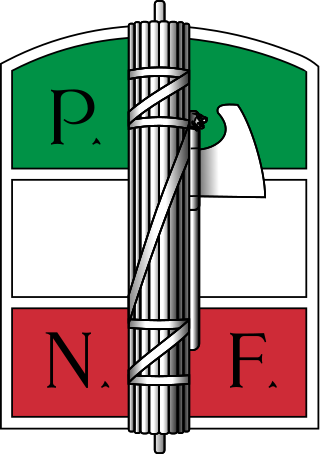Related Research Articles

Opera Nazionale Balilla (ONB) was an Italian Fascist youth organization functioning between 1926 and 1937, when it was absorbed into the Gioventù Italiana del Littorio (GIL), a youth section of the National Fascist Party.

The National Fascist Party was a political party in Italy, created by Benito Mussolini as the political expression of Italian fascism and as a reorganisation of the previous Italian Fasces of Combat. The party ruled the Kingdom of Italy from 1922 when Fascists took power with the March on Rome until the fall of the Fascist regime in 1943, when Mussolini was deposed by the Grand Council of Fascism. It was succeeded, in the territories under the control of the Italian Social Republic, by the Republican Fascist Party, ultimately dissolved at the end of World War II.
Women in Italy refers to females who are from Italy. The legal and social status of Italian women has undergone rapid transformations and changes during the past decades. This includes family laws, the enactment of anti-discrimination measures, and reforms to the penal code.
This is a list of words, terms, concepts, and slogans in the Italian language and Latin language which were specifically used in Fascist Italian monarchy and Italian Social Republic.
Feminism in Italy originated during the Italian renaissance period, beginning in the late 13th century. Italian writers such as Moderata Fonte, Lucrezia Marinella, and others developed the theoretical ideas behind gender equality. In contrast to feminist movements in France and United Kingdom, early women's rights advocates in Italy emphasized women's education and improvement in social conditions.

Lilia Silvi was an Italian film actress. Silvi was one of several young actresses presented as an Italian equivalent to the Canadian-born Hollywood star Deanna Durbin. She appeared opposite Amedeo Nazzari, the most popular Italian star of the era, in five films.

The Kingdom of Italy was governed by the National Fascist Party from 1922 to 1943 with Benito Mussolini as prime minister and dictator. The Italian Fascists imposed totalitarian rule and crushed political and intellectual opposition, while promoting economic modernization, traditional social values and a rapprochement with the Roman Catholic Church.
The Associazione per la donna, also Associazione Nazionale per la donna, was an early Italian women's organization. Founded in Rome in 1896 by a group of women, including Elisa Agnini, Giacinta Martini Marescotti, Alina Albani, Virginia Nathan, Maria Montessori and Eva De Vincentiis, it was among the first to deal with women's civic and political rights.
The Comitato pro suffragio femminile was an Italian organization founded in 1905 in support of women's voting rights. Among the most active participants were Anna Maria Mozzoni, Linda Malnati and Carlotta Clerici.
Piera Fondelli Gatteschi was the commander of the Female Auxiliary Service of the Italian Social Republic, a member of the National Fascist Party and a participant in the March on Rome.
Graziella Sonnino Carpi was an Italian feminist and peace activist in the interwar period. She was a member of the Italian Unione Femminile Nazionale and a delegate to the 1919 Women's Conference.
Massaie Rurali was an Italian organisation for peasant women within the Italian Fascist Party (PNF). MR was founded in 1933 and disbanded in 1945. It was the largest women's organisation in Fascist Italy and one of the largest organisations, with more than three million members in 1943.
Fasci Femminili (FF) ("Female Groups") was the women's section of the Italian Fascist Party (PNF). The FF was founded in 1919 and disbanded in 1945. It incorporated all the other Fascist organizations for women and girls, which were all formally sections of the FF.
Angiola Moretti, was an Italian politician of the National Fascist Party (PNF).
Laura Marani Argnani (1865-1955), was an Italian politician of the National Fascist Party (PNF).
Giuditta "Itta" Stelluti Scala Frascara was an Italian politician of the National Fascist Party (PNF).
Clara Franceschini, was an Italian politician of the National Fascist Party (PNF).
Baroness Teresita Menzinger Ruata, was an Italian politician of the National Fascist Party (PNF).
Wanda Bruschi Gorjux (1889-1976), was an Italian politician of the National Fascist Party (PNF).

Olga Medici del Vascello (1882-1966), was an Italian politician of the National Fascist Party (PNF).